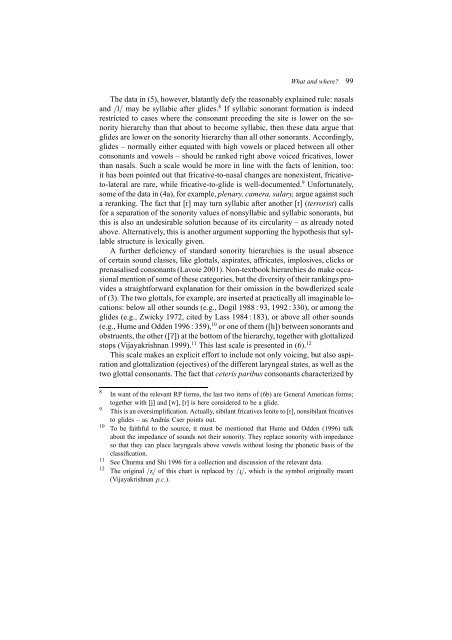What and where? Péter Szigetvári - SEAS
What and where? Péter Szigetvári - SEAS
What and where? Péter Szigetvári - SEAS
You also want an ePaper? Increase the reach of your titles
YUMPU automatically turns print PDFs into web optimized ePapers that Google loves.
<strong>What</strong> <strong>and</strong> <strong>where</strong>? 99<br />
The data in (5), however, blatantly defy the reasonably explained rule: nasals<br />
<strong>and</strong> /l/ may be syllabic after glides. 8 If syllabic sonorant formation is indeed<br />
restricted to cases <strong>where</strong> the consonant preceding the site is lower on the sonority<br />
hierarchy than that about to become syllabic, then these data argue that<br />
glides are lower on the sonority hierarchy than all other sonorants. Accordingly,<br />
glides – normally either equated with high vowels or placed between all other<br />
consonants <strong>and</strong> vowels – should be ranked right above voiced fricatives, lower<br />
than nasals. Such a scale would be more in line with the facts of lenition, too:<br />
it has been pointed out that fricative-to-nasal changes are nonexistent, fricativeto-lateral<br />
are rare, while fricative-to-glide is well-documented. 9 Unfortunately,<br />
some of the data in (4a), for example, plenary, camera, salary, argue against such<br />
a reranking. The fact that [r] may turn syllabic after another [r] (terrorist) calls<br />
for a separation of the sonority values of nonsyllabic <strong>and</strong> syllabic sonorants, but<br />
this is also an undesirable solution because of its circularity – as already noted<br />
above. Alternatively, this is another argument supporting the hypothesis that syllable<br />
structure is lexically given.<br />
A further deficiency of st<strong>and</strong>ard sonority hierarchies is the usual absence<br />
of certain sound classes, like glottals, aspirates, affricates, implosives, clicks or<br />
prenasalised consonants (Lavoie 2001). Non-textbook hierarchies do make occasional<br />
mention of some of these categories, but the diversity of their rankings provides<br />
a straightforward explanation for their omission in the bowdlerized scale<br />
of (3). The two glottals, for example, are inserted at practically all imaginable locations:<br />
below all other sounds (e.g., Dogil 1988 : 93, 1992 : 330), or among the<br />
glides (e.g., Zwicky 1972, cited by Lass 1984 : 183), or above all other sounds<br />
(e.g., Hume <strong>and</strong> Odden 1996 : 359), 10 or one of them ([h]) between sonorants <strong>and</strong><br />
obstruents, the other ([P]) at the bottom of the hierarchy, together with glottalized<br />
stops (Vijayakrishnan 1999). 11 This last scale is presented in (6). 12<br />
This scale makes an explicit effort to include not only voicing, but also aspiration<br />
<strong>and</strong> glottalization (ejectives) of the different laryngeal states, as well as the<br />
two glottal consonants. The fact that ceteris paribus consonants characterized by<br />
8<br />
In want of the relevant RP forms, the last two items of (6b) are General American forms;<br />
together with [j] <strong>and</strong> [w], [r] is here considered to be a glide.<br />
9<br />
This is an oversimplification. Actually, sibilant fricatives lenite to [r], nonsibilant fricatives<br />
to glides – as András Cser points out.<br />
10<br />
To be faithful to the source, it must be mentioned that Hume <strong>and</strong> Odden (1996) talk<br />
about the impedance of sounds not their sonority. They replace sonority with impedance<br />
so that they can place laryngeals above vowels without losing the phonetic basis of the<br />
classification.<br />
11<br />
See Churma <strong>and</strong> Shi 1996 for a collection <strong>and</strong> discussion of the relevant data.<br />
12<br />
The original /ü/ of this chart is replaced by /õ/, which is the symbol originally meant<br />
(Vijayakrishnan p.c.).
















